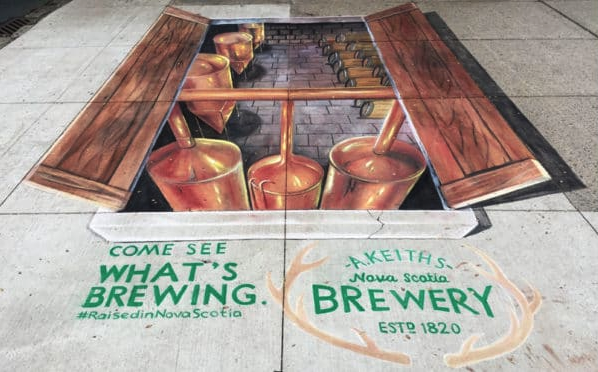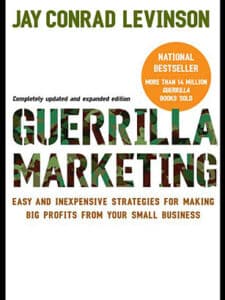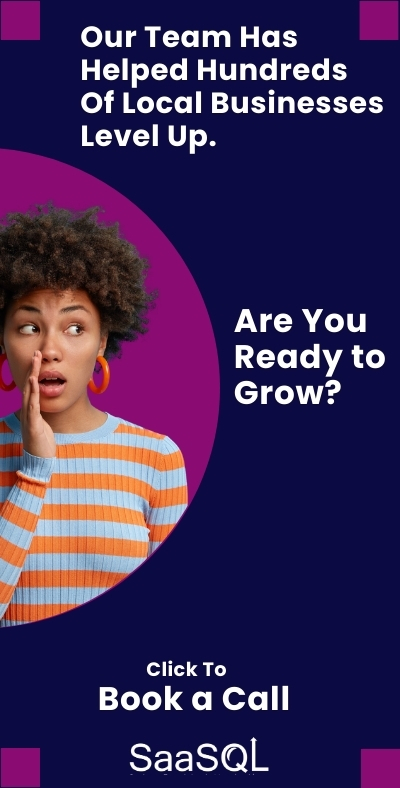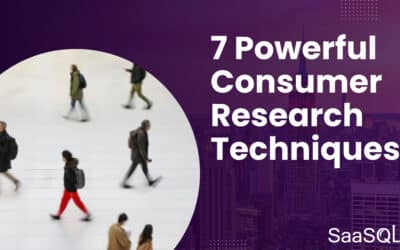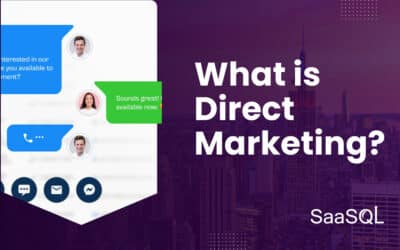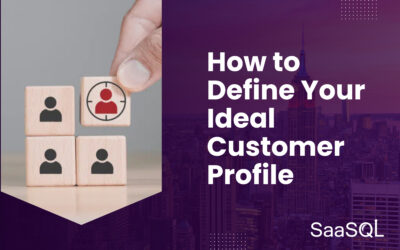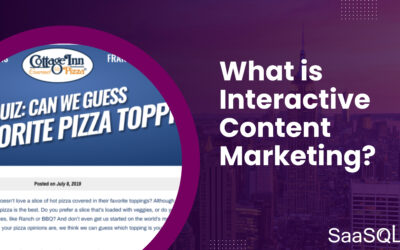During the major league baseball post season in 2022, viewers were treated to something decidedly creepy. A woman, standing in the front row behind home plate stared out toward the game with a large and disquieting grin on her face. For the entire game. The broadcasters noticed, the fans noticed and social media certainly noticed.
Before long, it became clear that this was one of the most immediate and successful forms of guerrilla marketing that that had been seen in recent years. But more on that, later.

For now, let’s focus on our own disquieting reality: as marketers, we spend our time navigating the twists and turns of creating standout campaigns that make people stop in their (digital) tracks, often only to find that we remain one of a hundred reasonable consumer options. Running an agency (like SaaSQL) that efforts to differentiate hundreds of client campaigns each month, the problem is only amplified.
Because this is an article about Guerrilla Marketing, we’ll approach the topic from the same perspective we approach all client campaigns. With the core understanding that it’s not just about being bold; it’s about connecting with your audience where they least expect it.
Guerrilla marketing isn’t new, but it definitely keeps evolving. With tech advancements like augmented reality and social media platforms playing huge roles now more than ever, it’s a matter of clear out-of-the-box thinking. In that spirit, get ready, because you’re about to dive into a marketing landscape filled with the unexpected.
Table Of Contents:
- What is Guerrilla Marketing?
- Guerrilla Marketing For Local Businesses (Who aren’t Burger King)
- Experiential and Ambient Marketing Tactics
- Creative Guerrilla Marketing Techniques
- Effective Street Guerrilla Marketing
- The Role Of Technology In Guerrilla Marketing
- Maximizing Brand Exposure Through Event Ambushes
- The Influence Of Jay Conrad Levinson On Guerrilla Marketing
- Conclusion
What is Guerrilla Marketing?
Imagine stumbling upon a park bench that transforms into a giant Kit-Kat bar or walking down the street only to find yourself in the middle of an impromptu concert. That’s guerrilla marketing for you – unexpected, unconventional, and as stealthy as its namesake warfare technique. It’s about making a big splash with creativity rather than splurging on ad space.
Definition and Explanation of Guerrilla Marketing
The term coined by business writer Jay Conrad Levinson doesn’t just echo military tactics but also mirrors their aim: capture attention quickly and effectively. In essence, guerrilla marketing strategies employ surprise interactions within public spaces to promote products or services in memorable ways. The goal? To generate buzz and drive word-of-mouth advertising without breaking the bank.
This low-cost approach can lead to high-impact results, especially when it goes viral—just think back to Burger King’s Moldy Whopper campaign which showed their burger decaying over 34 days, highlighting their removal of artificial preservatives—a bold move that sparked conversations worldwide.
Creative Guerrilla Marketing Ideas and Examples
If we look at creative guerrilla marketing examples like Burger King’s moldy whopper saga, they didn’t just talk about ditching preservatives; they showed it in a way that turned heads (and stomachs). This provocative strategy paid off because it wasn’t what people expected from fast food advertising—it was honest-to-the-core branding served up fresh… well sorta.
In similar fashion but on more appetizing notes M&M’S took guerrilla marketing up another notch, blending humor with relatable moments through life-sized candies engaging passersby across city streets.
Then, of course there’s the example that kicked us off. When Paramount bought a single ticket for 3 MLB playoff games the week before their film “Smile” was released in theaters, no one could have anticipated the outcome. For those who had seen the trailers and were thinking about seeing the movie, the tie-in was immediately recognizable. For those who didn’t know what was going on, MLB broadcasters were happy to fill you in.
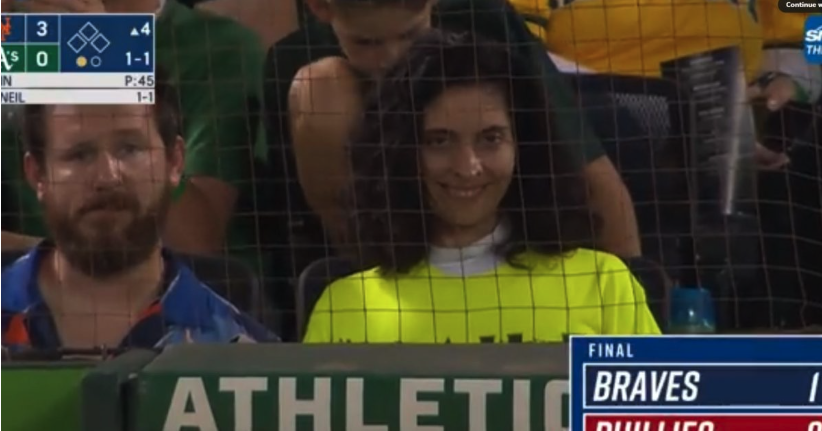
To sum it all up succinctly: Guerrilla marketing thrives on ingenuity. It leverages elements like shock value or playfulness to draw us into narratives where brands become protagonists—or sometimes antiheroes—in our everyday tales. So next time you see something outlandish yet oddly fitting around town remember: there might be some clever marketers behind this ploy.
Guerrilla Marketing For Local Businesses (Who aren’t Burger King)
Of course, perhaps it’s easy for businesses who can spend $ millions on creative efforts to achieve some degree of virality with their marketing. But what about the rest of us? How can local businesses utilize guerrilla marketing tactics to impact their businesses?
For local businesses, the core goal should be about community engagement. In other words, the best outcome is one that takes advantage of the key advantage that local businesses have: they’re LOCAL. Guerrilla Marketing offers local small businesses a unique and cost-effective way to stand out in their communities and compete with larger competitors.
Leveraging Low-Cost Strategies for High-Impact Results
The beauty of guerrilla marketing lies not only in its ability to surprise but is often one of the most low cost marketing tactics—a welcome relief for small businesses competing against industry giants without breaking the bank. A professionally designed stencil sprayed onto sidewalks at high foot-traffic locations might catch more eyes than expensive billboard ads ever would.
A smartly executed guerrilla idea doesn’t have big dollar signs attached; instead, success hinges on being memorable enough so people feel compelled to talk about what they’ve witnessed—a strategy Burger King knows all too well after their moldy revelation became one heck of a conversation starter.
Experiential and Ambient Marketing Tactics
Investigate how ambient and experiential approaches create engaging brand interactions that resonate with consumers on a personal level.
The Surprise El ement of Ambient Advertising
ement of Ambient Advertising
Discover how ambient marketing can elevate your brand with low-cost, high-impact strategies that captivate audiences and create memorable experiences.
Folgers’ innovative use of manhole covers demonstrates ambient advertising’s potential to surprise and engage passersby. Check out the Folgers manhole campaign to see how they turned steamy manholes into steaming cups of coffee. These types of hands-on approaches engage consumers through all senses, going beyond standard billboards or web ads.
Experiential marketing often involves pop-up events or interactive installations, inviting people to experience the brand’s story firsthand. These unique and share-worthy experiences can go viral, propelling brands into the social media spotlight effortlessly.
Folgers’ creative twist demonstrates how surprise elements make ambient advertising resonate so effectively with passersby—they didn’t expect their morning commute would include walking over giant cups of coffee. This form not only captures attention but also creates memorable impressions, boosting word-of-mouth recommendations—a goldmine for marketers aiming to generate buzz without breaking the bank.
By utilizing creative and unconventional tactics local businesses can capture the attention of their target audience in memorable ways. These tactics not only generate buzz and excitement but also foster a sense of community engagement and connection. Unlike traditional advertising methods that may require hefty budgets, Guerrilla Marketing allows small businesses to maximize their resources and creativity to make a big impact locally.
Creative Guerrilla Marketing Techniques
Guerrilla marketing hits the streets where it’s raw, real, and can’t be ignored. Imagine walking downtown and a group suddenly breaks into a flash mob. It grabs your attention, right? That’s street guerrilla marketing at play—unexpected and unforgettable.
The beauty of these tactics lies in their ability to leverage high-traffic urban areas for maximum visibility. Whether it’s through impromptu concerts or thought-provoking street art, these approaches create moments that people feel compelled to share both offline and on social media platforms. Think about it: you’re more likely to remember an ad tied to that surprise performance you stumbled upon than another billboard along the highway.
But let’s get specific; how effective are these strategies really? Flash mobs aren’t just for entertainment—they’ve been shown to significantly draw attention towards a brand or cause when executed well. Similarly, impromptu concerts not only captivate live audiences but also rack up views online as spectators upload footage across various media platforms.
A prime example is street guerrilla campaigns, which often become viral sensations due to their unique nature—sparking conversations and increasing brand awareness without needing the deep pockets of traditional advertising channels.
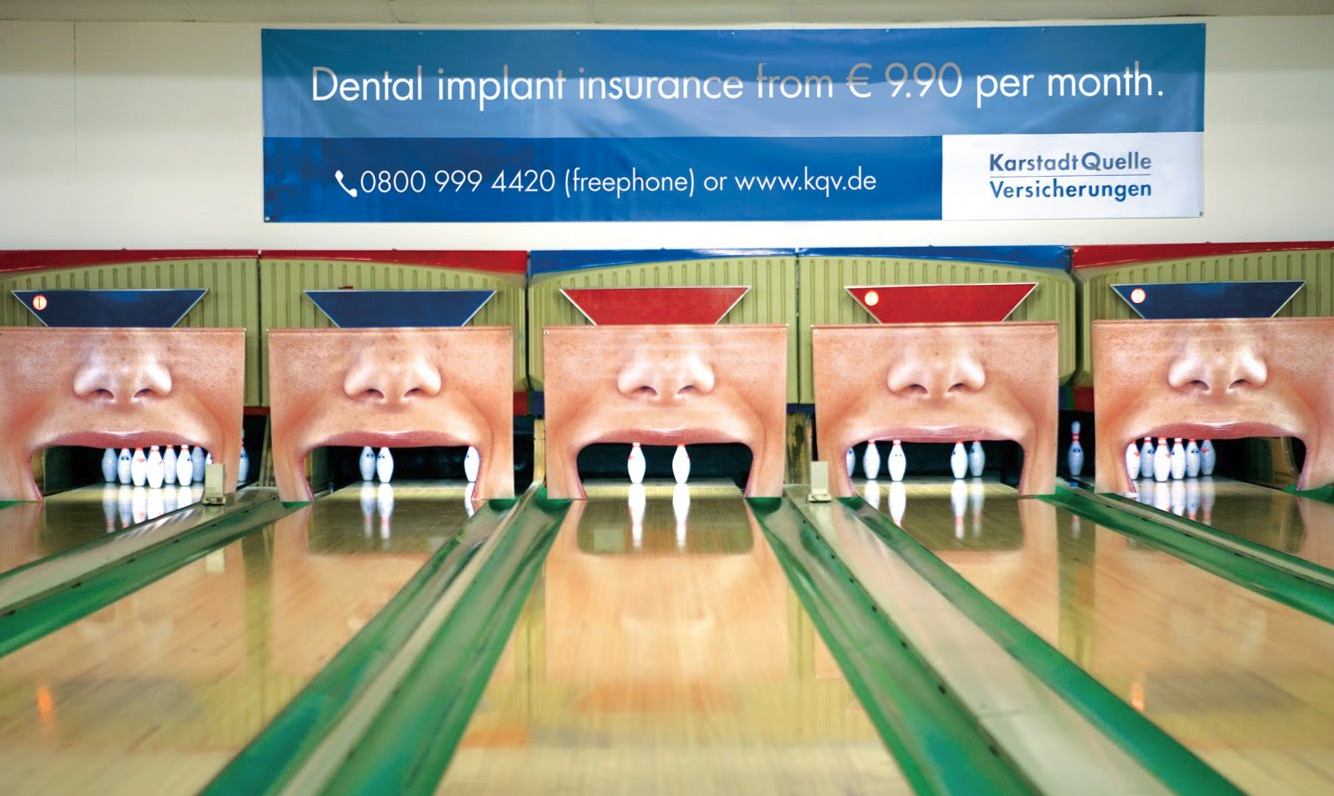
Strategic Partnerships: And last, but certainly not least, partnering with other local businesses to create unexpected campaigns. Sometimes the more unexpected the partnership, the better. As in this case, where a local orthodontist partnered with a bowling alley to market dental implants. A creative use of guerrilla marketing that was specifically designed to generate local business leads. Sometimes the impact speaks for itself.
Flash Mobs: Organizing spontaneous and unexpected performances or events in public spaces to attract attention.
Stickers and Posters: Placing eye-catching stickers or posters in strategic locations. Many businesses have utilized this tactic in a way that have made them increasingly interactive. For example, including QR Codes, or inviting the public to add or subtract from the poster in a way that updates it in some way.
Publicity Stunts: Creating memorable and attention-grabbing events or actions that generate buzz.
Effective Street Guerrilla Marketing
Sidewalk Chalk Art: Creating temporary chalk art on sidewalks to promote a business or event. While not strictly limited to chalk, many guerrilla marketing campaigns have used street art to create stunning visual effects that attract attention and engage the audience.
This approach has been used by brands like Jinro, Sony Ericsson, BMW, and for various events and campaigns, demonstrating the versatility and impact of street art in guerrilla marketing. Still, while it is clearly a useful tool for multinational corporations, it has quickly become one of the most resourceful ways for local businesses to make an impact, as well. All you need is chalk and a talented artist to tell your story, like the one pictured for Alexander Keith beer from an experiential agency called Grassroots Marketing.
Pop-Up Shops: Setting up temporary retail spaces in unexpected locations.
Street Performers: Hiring street performers to promote a business or event.
Customized Vehicles: Decorating vehicles with branding or messages and driving them around high-traffic areas.
These are just a few examples, but local businesses often get creative with Guerrilla Marketing to stand out in their communities. You may find more specific examples by searching for local businesses in your area that have gained attention through unconventional marketing tactics.
The Role Of Technology In Guerrilla Marketing
Guerrilla marketing has always thrived on the unexpected, and technology is pushing those boundaries even further. By weaving digital elements into guerrilla marketing campaigns, marketers are creating experiences that stick with you longer than a pop-up ad ever could.
Integrating Social Media Platforms
Social media isn’t just for selfies and viral dances; it’s a gold mine for guerrilla marketers looking to explode their reach. Imagine an art installation in a city park that comes alive through Snapchat filters or Instagram Stories, instantly shared across multiple time zones. It turns local stunts global faster than you can hit ‘like’. Digital platforms have become essential channels where creativity meets strategy to generate buzz around every corner of the internet.
Digital landscapes morph at warp speed—today’s trend might be tomorrow’s old news. So successful campaigns use social media not just as loudspeakers but as engagement hubs where brands connect with people through comments, shares, and likes—the currency of online attention.
Augmented Reality Campaigns
Augmented reality (AR) isn’t sci-fi anymore—it’s now one of the most engaging tools in a marketer’s arsenal. Remember when Pokémon GO had everyone roaming streets hunting virtual creatures? That was AR making waves in real-time. Now imagine leveraging such tech to overlay your brand story onto everyday surroundings—a mural that moves when viewed through your phone or packaging that tells stories beyond static images.
Take M&M’s AR game experience. By simply scanning a package with your phone, you could unlock a whole new world blending digital excitement with real-world snacking.
For local businesses, instead of developing a custom AR app, using existing platforms is likely the key. For example:
- Instagram and Snapchat Filters: Create branded AR filters for these platforms. They can be used for promoting events, products, or just for engaging with the community.
- Facebook AR Ads: Use AR features in Facebook ads to allow potential customers to try products virtually.
This fusion of digital visuals with physical spaces does more than catch eyes; it immerses viewers into narratives only limited by imagination itself—and often leaves them wanting more from these innovative interactions embedded within our daily lives.
Key Takeaway:
Burger King’s Moldy Whopper wasn’t just a shocker; it was guerrilla marketing gold that got the whole world talking about their fresh ingredients. Brands are ditching expensive ads for street art and flash mobs, turning everyday places into viral sensations with creativity as their slingshot.
Augmented reality is making waves by transforming candy wrappers into interactive adventures—proving fun tech experiences can spread like wildfire on social media.
Guerrilla tactics offer big impact without the hefty price tag. Think sidewalk stencils over billboards—a clever move to make people stop, stare, and share your story without spending a fortune.
Maximizing Brand Exposure Through Event Ambushes
Ambushing a big event might sound like something out of a spy movie, but in the world of guerrilla marketing, it’s pure gold. It’s about getting your brand smack dab in the middle of the action without being an official sponsor. Think of it as showing up to the party uninvited and still becoming the life of it.
Take Nike for example. They’re not strangers to event ambushes—like that time they turned heads during the 1996 Olympics with their guerrilla tactics while Reebok paid millions for official sponsorship rights. Now that’s what you call a marketing full-court press.
The key here is creativity and boldness because these stunts need to grab attention faster than freebies at a fan fest. When done right, this strategy can spread through social media platforms quicker than wildfire, ramping up your brand exposure exponentially.
Spotlight on Successful Event Ambushes
We’ve seen some brilliant moves when brands have gatecrashed events without coughing up sponsor fees—and boy do they make waves. For instance, consider Dr. Dre’s Beats headphones; athletes wore them around London during an international sporting spectacle despite another audio company holding exclusive rights.
This kind of move makes noise—a lot more buzz than traditional ads could ever hope to generate. The result? A guerrilla win with audiences worldwide tuning into those rebellious vibes.
But remember folks: respect is crucial too because there’s thin ice between edgy and intrusive; so play smart if you want to hit home runs instead of foul balls.
Finding Your Ambush Moment
If you’re plotting an event ambush yourself, start by identifying gatherings where your target audience hangs out en masse—music festivals are ripe territory for dropping surprises or product samples on festival-goers caught off-guard by delight (or curiosity).
You’ll want something memorable that fits seamlessly into their experience—it should feel less like advertising and more like discovering treasure amidst celebration madness.
- Burger King knew this well when they served up moldy Whopper burgers,
- Snickers hilariously tackled fashion week hunger,
- M&M’s went all-in with character-driven antics at public venues,
Your goal? Make people talk about your stunt long after curtains close on any given night… Because let me tell ya’, word-of-mouth endorsements from thrilled attendees beat five-star reviews any day.
Key Takeaway:
Show up and steal the show like Nike did at the Olympics without paying big sponsor bucks. Get creative, be bold, and make a splash that’ll get everyone talking.
Wear respect like a badge while you cleverly crash parties; it’s all about making waves without wiping out.
Find where your crowd thrums to drop unexpected delights. Aim for memorable moments that spark stories, not just ads—think moldy burgers or Snickers at fashion week.
The Influence Of Jay Conrad Levinson On Guerrilla Marketing
Business writer Jay Conrad Levinson coined the term guerrilla marketing, sparking a revolution in how we think about brand promotion. His ideas emphasized that creativity trumps budget size, showing small businesses they could make a big splash without breaking the bank.
Jay’s philosophy pivoted on innovative tactics reminiscent of guerrilla warfare—unexpected and unconventional moves designed to catch people off guard and generate buzz. This approach has been crucial for companies looking to stand out in cluttered marketplaces. For instance, Burger King’s moldy Whopper campaign turned heads by highlighting their removal of artificial preservatives—an audacious move that exemplified Jay’s principles perfectly.
Social media platforms have become pivotal battlegrounds where these guerrilla strategies unfold daily. The right post can go viral overnight, reaching millions at minimal cost. Companies now aim for this level of impact with campaigns crafted to draw attention as effectively as street art captures the gaze of passersby or flash mobs turn mundane moments into memorable experiences.
In essence, every successful guerrilla marketing idea today still whispers hints from Levinson’s playbook—whether it’s an augmented reality surprise that transforms city sidewalks or cleverly placed event sponsors that captivate audiences during Fashion Week shows.
To honor his legacy and learn more about how his teachings remain relevant in our digital age, delve into the wealth of resources discussing his influence on modern-day marketers. As you explore creative guerrilla marketing examples like those mentioned above or study ambient advertising marvels such as Folgers’ manhole covers, see here, remember: It all started with one visionary who redefined what it means to get your brand noticed.
Conclusion
Remember, guerrilla marketing is about making a splash with less cash. It’s creativity over budget, surprise over blandness.
Think outside the billboard. Use social media to engage with consumers in unexpected ways. Use technology like augmented reality for immersive ads.
Ambush events for exposure, lean on tech for impact. Small businesses can play in the big leagues using these tricks of the trade.
Embrace street smarts; relevant installations, flash mobs and urban art catch eyes and open minds.
Last but not least: make it personal. Connect with people where they live, work and play—and watch your brand grow strong roots in their world.



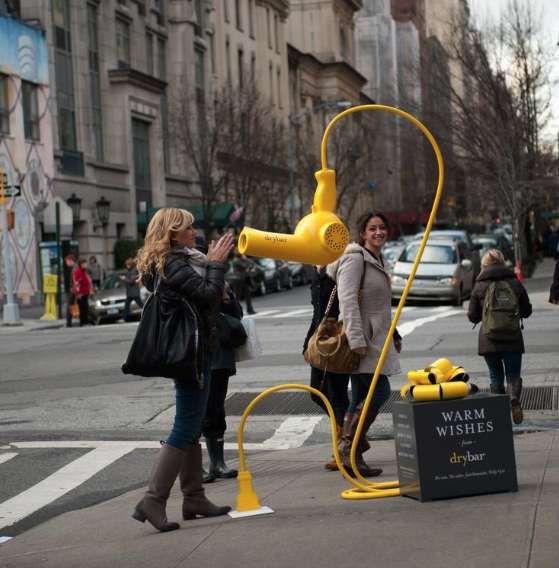 ement of Ambient Advertising
ement of Ambient Advertising